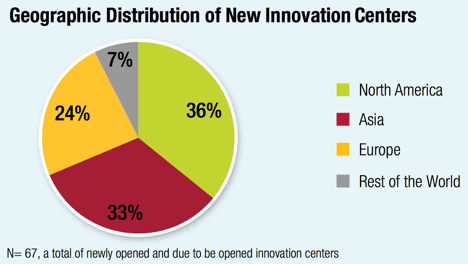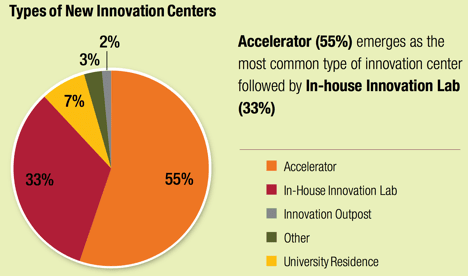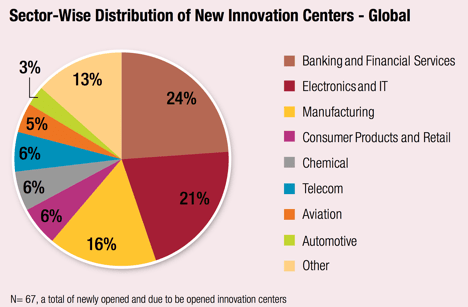
Startups continue to push industries and technologies forward (and sideways) regardless of fluctuations in valuation and funding. At the same time, large companies around the world are scrambling to become part of the bustling startup culture to compete against, invest in or partner with promising entrepreneurs. Basically, organizations, largely criticized for their lethargic approach to change and contention, are looking at fledgling disruptors as a means or bridge toward the type of fresh perspective and ingenuity that’s often missing inside. Without it, companies are hampered in the ability to gain new market share and profitability while also becoming increasingly exposed to the threat of irrelevance or disruption at the same time.
So, what hope do large, slow, complicated organizations have against the world’s Google’s, Facebook’s, Uber’s or whoever’s next? The answer lies in the rise of innovation centers and the ability to think and act like the very startups that represent accelerated progress or even disruption.
In 2015, I partnered with CapGemini’s Jerome Buvat to publish the industry’s first global corporate innovation study, “The Innovation Game: Why & How Businesses are Investing in Innovation Centers.”
We then followed it up with an update to that report, “The Rise of Innovation Empires,” which documented the evolution and expansion of innovation centers around the world.
Here’s what we found…
New Hubs of Innovation Centers have Emerged Across the World

Silicon Valley is no longer the sole breeding ground for innovation. Hubs of innovation centers are taken root all over the world and are no longer concentrated in a handful of technology hubs. Top 10 most favored locations for innovation centers only represent 35% of total innovation centers, indicating that the growth of innovation hubs is becoming uniform globally.
The innovation center phenomenon continues to spread globally and has given rise to several new innovation empires. Our previous research (CapGemini + Altimeter Group, a Prophet company) analyzed more than 300 innovation centers opened by the top 200 global organizations. In the six months following our initial report (July 2015 to February 2016), 56 new innovation centers opened in 20 countries with an additional 11 centers in development.
Silicon Valley Western Europe has also strengthened its position as leading hotbeds of innovation. Since the last report, five and 12 new innovation centers opened in these regions respectively. Additionally, within the Eastern US, three new innovation centers have opened in Atlanta and two in Boston are home to three and two new innovation centers. Around the world, India (Bangalore) now hosts four new innovation centers and in Australia, two new innovation centers have opened in each Sydney and Melbourne.
Majority of New Innovation Centers Operate as Accelerators

Organizations see a lot of value in operating their innovation centers as internal accelerators. 55% of new innovation centers, opened or announced between July 2015 and February 2016, are in fact, accelerators.
What’s the difference?
Accelerators engage with the local ecosystem, cultivate relationships with startups and entrepreneurs and provide them opportunities to collaborate on technology solutions.
In-house innovation is the second-most favored model representing 33% of new innovation centers. Serving as the innovation engine for these companies, in-house innovation labs are typically large in size, and perform all innovation activities from inception to prototyping using an in-house approach.
Very few innovation centers favored ‘university residence’ and ‘innovation outpost’ models that witnessed only 7% and 2% of new innovation centers adopting them respectively. This means that organizations are maturing in their innovation models from experimental to more structured approaches that require significant monetary and resource commitments.
Financial Services Leads Other Industries in Opening New Innovation Centers

The Financial Services industry has fast caught up with others in terms of opening up new innovation centers. Our new research shows that 42% of top FS organizations now have innovation centers against 28% in H1 2015.
Between July 2015 and February 2016, the number of innovation centers grew the highest in Financial Services (by 145%), overtaking Manufacturing (which grew by 48%) and Consumer Products (which grew by 33%). Further, financial technology (fintech) emerged as the second-most improtant focus area for new innovation centers with 13% of new innovation centers focusing on it. This is notworthy as Fintech was not listed in the top six focus areas for innovation centers identified in July 2015.
Digital Technologies Remain on Top of Innovation Center Focus Areas
Disruptive technology is at the forefront of work in all innovation centers. The Internet of Things, Fintech and Digital Healthcare have emerged as the top three priority areas for innovation centers whereas Big Data/Analytics has fallen behind. In fact, just 10% of new innovation centers cite Big Data/Analytics as a focus area compared to 51% identified till July 2015.
Corporate Innovation Centers are Plugging into Startup Ecosystems

Organizations are also realizing the importance and value in partnering with relevant startups and ecosystem players over just gaining access to new technology. ‘Partnering with ecosystem’ emerged as the key objective of new innovation centers contrasting our previous finding, ‘gaining access and exposure to latest technologies’, which was the main mission of innovation centers in our previous research.
Innovative Approaches to Innovation is Proving Necessar
Part of the allure of moving to Silicon Valley or any other “Silicon Valley of…” is to be part of a movement that changes the world. Otherwise, the extent of which you innovate (or iterate) is anchored to corporate culture, the level of risk or empowerment employees feel they work within or around or the legacy metrics that define yesterday’s work or standards of success.
Startup FOMO is now a global pandemic. As the second installment of our research shows, it affects everyone from entrepreneurs to executives in every industry across the globe. The difference between trying and doing however is separated by the ability to perform outside of norms and legacy standards. For big companies, that takes more than innovation centers. It takes leadership and a collaborative culture to effectively challenge convention and gain momentum in the face of conformity.
Get the TNW newsletter
Get the most important tech news in your inbox each week.




